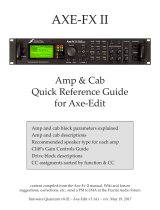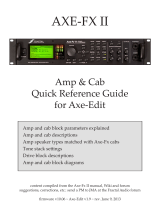
Carvin Bi-Channel
Tube &Solid-State Amplifiers
OPERATING - SERVICING MANUAL
The VTXand STXTube and Solid-State Bi-Channel Amps have beenengineered to provide the guitarist with amaximum
of control capability and a minimum of complexity. Two independent and identical channels, each feature continuouly
variable Preamp Drives, produce outputs ranging from a clean, undistorted output to a heavy Harmonic Sustain output.
Master Volumes allow independent level control, and seperate Reverb and Graphic EQ circuitry contribute to an almost
infinite variety of accoustic control.
Advantages of the Carvin Bi-Channel Amp: (1)Separate Channels for Bass andTreble guitar pickups (providing astereo
guitar is used). (2) Switching Channels for instant tone changes. (3) Cleanto Distortion Channel Switching. (4)Switching
for instant soft to loud volume changes for either clean or sustain output. (5)Double sustain or clean volume levels when
both channels are switched on. (6) Use as a BiAmp system when other components are added.
Other Bi-Channel Amp features include a fully balanced 600 Ohm Line Output for recording plus separate Channel
Interrupt Jacks for each channel.
The Bi-Channel Tube and Solid-State Amps are available in avariety of models depending upon the speakers ordered.
See the Carvin Equipment Catalog for exact model numbers.
VTX100 STX125 STX250
VTX112 VTX212 STX112 STX212 VTX-79
m
Z
GJ
-
Z
m
m
:n
-
z
GJ
o
~
}>
<
~
><
-4
o
o
CJ)
~
><
-4
N
en
CJ)
~
><
N
en
o

®@®@® ® ®
® ® @
® ® ®® @ @ ® ® ® @
@@ @ @@®@
FRONT PANEL
1. INPUTS
Three Standard Phone Plugs are located on the left side of the chassis. The top jack isthe input to Channel 1while the bottom jack
feeds Channel 2. The center jack allows one instrument to be fed into both channels simultaneously. Note that the center jack is
active only when the other two jacks are unused.
2. SUSTAIN DRIVE (Each Channel)
The DRIVE controls the input level of the first stage for the amount of sustain-compression. This dual series preamp configuration
provides extremely high gain, resulting in a natural distorted output.
The degrees of the Sustain depends upon the strength of the original signal as well as the setting of the DRIVE control. Thus, the
maximum effect will be obtained using "hot" pickups, the guitars volume up full, and the DRIVE control at maximum. However, too
much distortion can easily be created in which the DRIVE control should be turned down.
3. REVERB (Each Channel)
This control sets the desired amount of reverb in each channel. However, be certain that the FS-34 Foot Switch is plugged in and
the reverb switch depressed before the reverb will function. The FS-34 switches both channels simultaneously.
4. SUSTAIN SWITCH (Each Channel)
When set at "IN" the Sustain Switch electrically connects two pre-amps in series for sustain.
When set to "OUT" the series pre-amps are taken out of the channel circuitry and the amp functions normally. The MASTER then
controls the normal volume levels.
5. MASTER (Each Channel)
The MASTER control is used to set the overall sustain volume.when used in the sustain mode. Or the MASTER functions as the
normal volume control when the sustain circuitry is not used.
6. GRAPHIC EQUALIZER (Each Channel)
When all slider knobs are centered along the "zero line", the equalizer has no effect. By raising any slider off the zero line, a certain
portion of the audio spectrum is boosted. Lowering the slider from the zero line reduces the power inthe particular band. The left hand
sliders control the lower frequencies (bass) and the right hand sliders control the high frequencies (treble). The middle sliders control
the mid-frequencies.
The range of the equalizer has been optimized for use with musical instruments. However, due to the differences between
instruments, some sliders will have more apparent effect than others. Thus, the lowest 2 bands offer the greatest effect with the bass
guitar, while the higher bands have more effect with a six-string guitar.
Note: Due to the extreme high amplification created when the higher frequency sliders are boosted, a whistling oscillati~n may
occure with some guitars when the Sustain Drive and Master volumes are full on. In such a case, simply reduce the boost oUne High
Frequency sliders.
7. 1/2 RMS POWER OUTPUT SWITCH
In addition to pre-amp distortion, you may select for power amp diswrtion which will start earlier than normal. When you use this
switch do not expect a volume change when playing at lower levels as this switch does not effect the gain of the amp - just the total
RMS output! On the tube model you will have to wait approx. 30 sec. after switched before the output is limited. This is because the
plate voltage on the 12AX7 must drop ..
8. GROUND
When the amplifier is plugged into a properly wired 3-conductor outlet, this switch has little or no effect. However, if an older 2-
conductor outlet must be used with an adaptor, the GROUND Switch should be set to produce minimum hum and/or string "clicks".
9. POWER
The POWER Switch is pushed to the right to turn the unit on.
all
1~,&,~
a.n. a.n. a.o. aA an.. an.. an.. all
Parallel
2

~--
o
o
o
REAR PANEL
1. FUSE HOLDER
Access to the fuse can be gained by pushing the fuse-holder inwards, then turning counterclockwise. The type of fuse to be used is
printed just below the fuse-holder. Should the fuse ever fail, replace it with an identical fuse. Ifthe second fuse fails, then a problem is
indicated, and the amp should be serviced. To prevent unnecessary damage to the amplifier, NEVER USE A FUSE WITH A HIGHER
RATING.
2. LINE CORD
All Carvin equipment is supplied with 3-conductor line cords ending in grounding-type plugs. This arrangement will greatly reduce
the possibility of electrical shock, provided the equipment is used with 3-conductor grounding-type outlets, and provided these
outlets have been properly wired. If, at any time, electrical shock is experienced, disconnect the amplifier and have a qualified
technician correct the trouble.
Carvin does not recommend the use of the older, 2-conductor non-grounding type of outlets, as there is an increased danger of
electrical shock. Ifthis type of outlet is unavoidable, setting the GROUND switch for minimum hum will also minimize the possibility of
such shock.
3. STANDBY SWITCH (Tube Model)
Pushing the switch down places the amp into a Standby Mode. This switch removes the plate voltage from the tubes, leaving only
the filiments on. Inthis way the amplifier is effectively shut-off but ready for immediate turn-on without waiting forthe filiments to warm
up. This will also extend the tube life.
4. CHANNEL SWITCHING (FS-34 Foot Switch)
(Important: The Reverb will not function if the Foot Switch is not plugged in and de-pressed on). Your amp includes the FS-34 Foot
Switch which offers visual monitoring of both channels. Connect the FS-34 by inserting the Chrome Plug into the top jack and the
Black plug into the bottom jack as indicated on the rear pannel. Each Channel LED light turns onwhen the Channel is activated. Make
certain that you plug the instrument into the center jack for switching Ch to Ch. For Reverberation, depress the reverb foot switch as
required.
5. CHANNEL INTERRUPT
Each channel features a dual-circuit switching jack to provide interrupt access in each channel.
Full break-outlbreak-in capability is available when a dual-circuit (stereo) plug is used. This allows external processing units (such
as didital delay lines, paramtric equalizers, compressors, etc.) to be patched-in as desired. The tip terminal of the jack must be wired
to the unit's input, and the ring terminal wired to the unit's output.
The jack may also be used an an independent Channel-Out point using a standard phone plug with a cable going to the desired
equipment. However, when this is done the reverb system will not function.
If access to the channel is desired without interrupting the signal, simply use a stereo plug and wire the tip terminal to the ring
terminal.
The Channel Interrupt jacks present a low impedance line - high level signal intended to drive studio quality processing units. This
high level signal istoo much for most common effect devices that are designed to go between the Guitar and Amplifier. High distortion
will result if the effects device does not have an input attenuator control.
6. BALANCED LINE OUT
A fully balanced low-impedance signal is available for directly driving professional mixing consoles, snake cables, or other studio
equipment. This signal is taken from the input of the power amp and contains both channels.
7. IMPEDANCE SELECTOR (Tube Model)
The IMPEDANCE SELECTOR switch must be set to match the impedance of the speaker system being used. If more than one
speaker system is used, the total impedance must be calculated (see below) and the switch set to the resulting combined total
impedance.
8. SPEAKER OUTPUTS
Two Standard Phone Jacks are provided. These jacks are wired.in parallel. For maximum RMS power from the Solid-State
Models, load the amp down to its minimum rated speaker impedance. Do not go below the minimum rated impedance or the Short-
Circuit Protection System will start to limit the amps power output.
HOW TO DETERMINE SPEAKER IMPEDANCE
Single speakers and speaker systems are always rated by the manufacturer. Common impedances are Two, Four, Eight and
Sixteen Ohms, although other values are sometimes used.
When more than one speaker, or speaker system, is combined, however, the impedance changes. The three basic interconnect-
ing methods are shown, with the changes in impedance each method causes. Although the drawing shows single speakers,
the same is true of speaker systems.
l3

I
81 AMPING
81 AMP THEORY
Bi Amping is accomplished by dividing electronically the audio spectrum into two parts. One amplifier and speakers handles the Lo
Frequencies (Lo Pass) while another amplifier handles the Hi Frequencies (Hi Pass).
Advantages of Bi Amping are: (1) Lower distortion because the low frequencies do not distort the high frequencies. (2) Twice the
volume levels when using the same equivalent RMS power. (3) A stereo effect from the bass and treble pickups coming from 2 different
speaker locations.
REQUIREMENTS FOR 81 AM PING
One Carvin Bi Channel Amp with built-in power and speakers. One Power Amp only such ,as the Carvin SV125 and One Speaker
System such as the Carin M-412 (used for the low frequencies).
SET-UP FOR 81 AM PING
The 7 Band Graphic Equalizers in the Carvin Bi-Channel Amps make for a very good electronic crossover when adjusted for that
purpose.
Channel 1 should be used as the Bass (Lo Pass) pre-amp by using the rear CHANNEL 1 OUTPUT JACK and directing it into another
power amp such as the Carvin SV125 and M412 speaker system.
Channel 2 should be used as the Treble (Hi Pass) Amp inwhich the built-in power amp and speakers will function fine for that purpose.
EQUALIZER SETTINGS
Everyone will desire their own settings. We recommend that you experiment around with various settings. However, keep in mind that
Channel 1 (Lo Pass) should have all bass frequencies turned up and treble frequencies turned down. Likewise, Channel 2 (Hi Pass)
should have all bass frequencies turned off and high frequencies turned up.
AMPLIFIER SPECIFICATIONS
VTX100 TUBE SPECIFICATIONS:
TUBES: 4 EL34/6CA7's & 1 12AT7. POWER OUTPUT: 100W RMS.
THD: 5% SIN RATIO: 68 dB. SELECTABLE SPEAKER IMP: 2, 4 &8
Ohms. FREQ. RESPONSE: 30 to 20K Hz. SENSITIVITY: 12 mv for full
output.
STX125 SOLlD·STATE SPECIFICATIONS:
OUTPUT TRANSISTORS: 4 150W RCA Devices. POWER OUTPUT:
125W RMS @4 Ohms. THD: .25%. SIN RATIO: 72 dB. FREQUENCY
RESPONSE:10 to 30K Hz.SENSITIVITY: 12 mv for full output.
STX250 SOLlD·STATE SPECIFICATIONS:
OUTPUT TRANSISTORS: 8 150W RCA Devices. POWER OUTPUT:
250W RMS @2 Ohms and 160W RMS @4 Ohms. THD: .25%. SIN
RATIO: 72 dB. FREQUENCY RESPONSE: 10 to 30K Hz. SENSITIVITY:
12 mv for full output.
General Specifications for All Bi·Channel Models:
HAMMOND REVERB SYSTEM: 4C Hammond Tank with 30·4·milli·
second delay with a total 1.4 see tone decay. SPEAKER OUTPUTS: 2
Jacks. 3 Wire Grounded A.C. Power Cord. TOLEX covered, 7 core,
marine plywood cabinet. Gold·finished chassis, constructed of 16
gauge steel. SIZE: 24W x 10D x 10H. WARRANTY: 2 Years Parts and
Labor, 90 Days Tubes.
LIMITED WARRANTY
Your Carvin Instrument Amplifier is protected against failure for 2YEARS. The amplifier will be serviced by Carvin free of charge
should anything go wrong within the warranty period (excluding tubes, if so equipped).
While Carvin suggests you utilize the specialized technicians of the Carvin Service Dept. Non-factory repairs will not void the
warranty, although all charges for such repairs must be paid by the customer. Furthermore, Carvin will supply amp parts (at no
charge) upon receipt of defective parts. Naturally, any damages caused by improper outside repairs will not be covered by the
warranty. All Shipping charges are to be paid by the Customer.
Carvin MagnaLab Speakers are warrantied for aperiod of 1Year and should be returned to us for repair if found defective (not
caused from excessive power). All Gauss and JBL speakers are warrantied for 5Years by their own manufactures -Not Carvin.
These speakers must be sent to their own service centers for repair.
Speakers are not warrantied against damage caused by excessive power levels. (Open Voice Coils are not covered by
warranty as they are the result of excessive power applications). The description of an open voice coil is: Aspeaker that will give no
sound. NOTE: An amplifier's rated output is specified at alow value of distortion. By overdriving the amp, substantially higher
wattages are produced, so caution is advised to prevent damage to the speaker system.
All above warranties are extended to the Original Purchaser Only, by the Carvin Co., and do not cover failures caused by misuse
or natural disasters.
4Carvin 1155 Industrial Ave., Escondido, Calif. 92025
/




